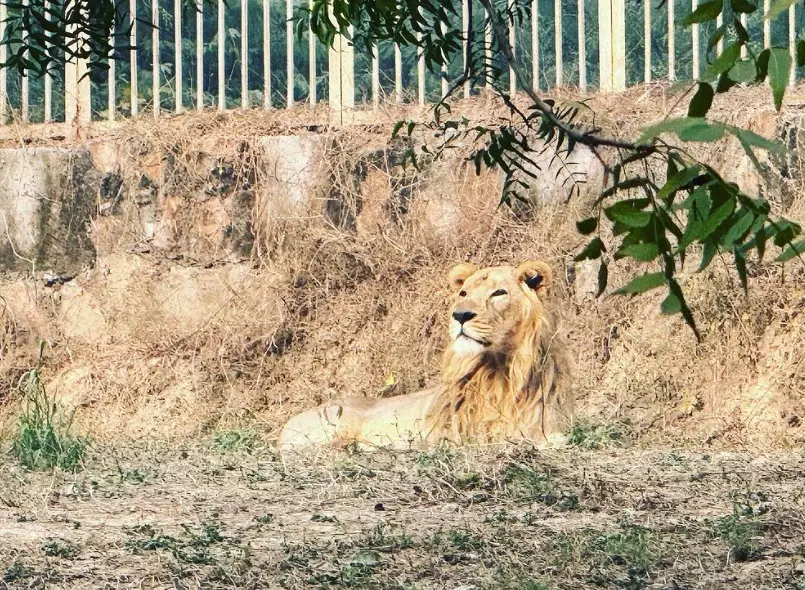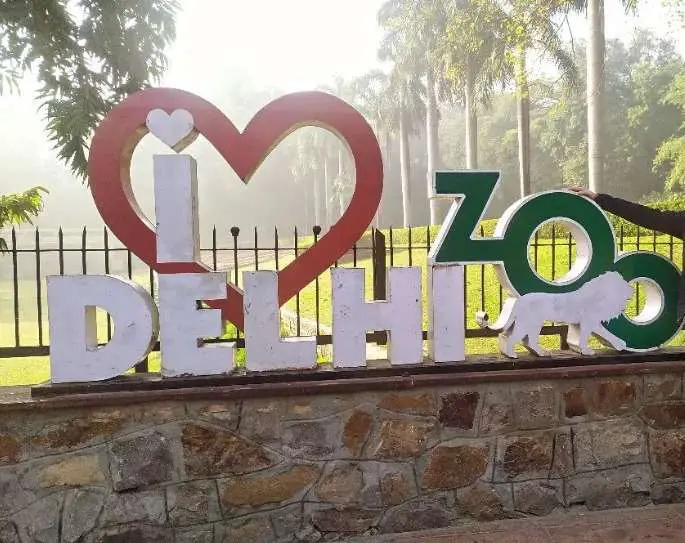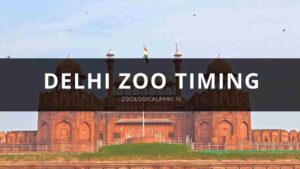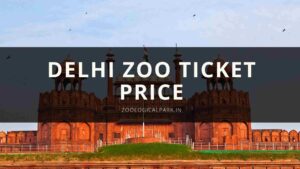Nestled near the historical Old Fort in the heart of New Delhi, the National Zoological Park, also known as Delhi Zoo, beckons wildlife enthusiasts and families alike. It’s a verdant expanse, stretching across 176 acres, that offers a refreshing escape from the city’s hustle and bustle.
Boasting a collection of around 1,350 animals across 130 species from around the world, the zoo is a biodiversity treasure trove. From the majestic Royal Bengal Tiger to the graceful Indian Rhinoceros, visitors can marvel at the rich tapestry of fauna on display.
Table of Contents
History of Delhi Zoo National Zoological Park
The seeds for the creation of the Delhi Zoo were planted in the early 1950s with a vision to offer a serene retreat within the bustling capital city of India. The National Board for Wildlife, established in 1951, played a pivotal role, appealing for a zoo in Delhi that would not only serve as a leisure space but also contribute to wildlife conservation.

A dedicated committee, under the stewardship of E.F. Bowring Walsh, solidified the idea, which received the green light by December 1956 after meticulous planning. Smt Indira Gandhi was among the influential figures endorsing the project, selecting the land between Purana Qila and Humayun’s Tomb as the site for this ambitious project.
Early Years and Initial Development
Upon approval, the construction of the zoo commenced swiftly. The inaugural chapter of the zoo’s history unfolded officially in 1959, after three years of intensive development of essential infrastructures like roads, waterways, and animal enclosures.
Distinguished forestry officer N.D. Bachkheti was instrumental during these formative years, overseeing the creation of a habitat that married aesthetics with functionality. Carl Hagenbeck, renowned for his innovative open moat enclosures, left an indelible mark on the zoo’s design philosophy, shaping it into a destination where animals thrived and visitors could engage with nature intimately.
Conservation Efforts and Expansion
From its inception, the Delhi Zoo has emphasised on conservation, positioning itself as a sanctuary for endangered species. With an ever-growing assembly of roughly 1,350 animals covering around 130 species, the zoo has evolved into a nexus for conservation with a far-reaching impact.
Its breeding programs, research initiatives, and educational efforts regarding wildlife conservation have set it apart as a conservation leader. The expansion of the zoo has been consistent, ensuring habitats are both diverse and representative of the species they house. This commitment to ecological balance and animal welfare emphasises the zoo’s role as a vital cog in the wheel of global conservation efforts.
Animal Habitat at Delhi Zoo National Zoological Park
The Delhi Zoo, officially known as the National Zoological Park, is a sanctuary for a vast array of wildlife. With meticulously designed habitats, the zoo provides a semblance of the wild, offering visitors an immersive experience while ensuring the well-being of its inhabitants.
The park’s dedication to simulating natural ecosystems is evident across its sections, catering to the specific needs of mammals, birds, reptiles, amphibians, and invertebrates.
Mammals
At the National Zoological Park, mammals thrive in habitats that closely mirror their natural environments. The zoo is home to some of the most fascinating creatures from both India and abroad. Prominent residents include the Royal Bengal Tiger, with its orange and white majesty, the powerful Asian Elephant, and the Indian Rhinoceros, all of which draw considerable attention.
Other significant species housed here are:
- The stoic Asiatic Lion
- The agile Leopard
- Herbivores like the Sambar, Chital, and Nilgai
- Unique species such as the Chousingha, a rare four-horned antelope
The exhibit layouts promote natural behaviours, encouraging breeding and providing spaces where animals can retreat for privacy. The habitats support complex ecosystems where these mammals can engage in activities like foraging, social interaction, and nurture their young.
Birds
Bird enthusiasts will find the bird section at the Delhi Zoo to be particularly delightful. It features both domestic and migratory species, each residing in aviaries that span different environments – wetlands to woodlands. Key attractions in the bird habitats include the flamboyant Peafowl, the stately Great White Pelican, and the majestic raptors like the Black Kite and Shikra.
Although some birds are not always on show due to ongoing renovations or seasonal migrations, visitors are often treated to the sight of exotic pheasants like the Golden Pheasant and the impressive Emu from the antipodes. The park also acts as an overwintering site for various migratory birds, promising a seasonally dynamic aviary population.
Reptiles
Reptiles at the National Zoological Park enjoy environments that are conducive to their ecological needs, with controlled temperature and humidity to replicate their natural habitats. Visitors have the opportunity to observe a range of reptilian life, from the menacing Marsh Crocodile to the less formidable but equally intriguing Tortoises.
The reptile house is a draw for those intrigued by these cold-blooded creatures, revealing a world where survival hinges on stealth and patience. Enclosures are designed to offer viewing opportunities while safeguarding the welfare of the animals.
Amphibians
Amphibians, while fewer in number compared to other taxa at the zoo, are given due consideration. The zoo ensures their aquatic and terrestrial requirements are met, allowing for the observation of these adaptable creatures as they transition between land and water. Species diversity in this category may include local frogs and other amphibians that showcase their unique life cycles and behaviours.
Invertebrates
Lastly, the Delhi Zoo dedicates space to invertebrates, celebrating the diversity of life in often overlooked forms. This section underscores the importance of every creature, no matter the size, in the broader ecological web. From industrious ants to intricately patterned butterflies, these invertebrates serve as crucial pollinators and waste recyclers in their ecosystems. The zoo strives to recreate microhabitats that support the different life stages and behaviours of these essential residents.
Each habitat at the National Zoological Park is a testament to the zoo’s commitment to preservation, research, and education, ensuring that the story of each species is told and their continued existence safeguarded. The zoo’s function as a haven for a plethora of living forms reinforces its status as a critical bastion of biodiversity amidst the urban sprawl of Delhi.
Exhibits and Attractions
Delhi Zoo, also known as the National Zoological Park, invites visitors to marvel at a diverse range of exhibits and attractions. The zoo’s focus is on education and conservation, giving guests a unique look into the wildlife of India and beyond. These exhibits are not just visually stimulating; they also play a pivotal role in research and the conservation of species.
Tiger Safari
At the heart of the National Zoological Park’s offerings is the exhilarating Tiger Safari. Royal Bengal Tigers, one of the zoo’s most treasured inhabitants, dazzle visitors with their majesty and power. Enclosed in an area that mimics their natural habitat, the tigers are seen lounging, playing, or stalking through the foliage. This controlled wilderness allows visitors to safely observe these magnificent creatures in a setting that prioritises their well-being, while also spotlighting the importance of tiger conservation efforts.
Butterfly House
A kaleidoscope of colours awaits at the Butterfly House, a dedicated space for these delicate insects. The house simulates a tropical garden rich with a variety of host plants that provide the perfect environment for several butterfly species. It’s a magical experience for visitors as they witness the life cycles of butterflies, from larva to the awe-inspiring moment of transformation into flying artworks. This attraction shines a light on the intricate role butterflies play in the ecosystem as pollinators.
Aviaries
The zoo’s aviaries are an ornithologist’s delight. Housing an impressive assortment of feathered creatures, the aviaries offer a glimpse into the complex avian world. Visitors can view everything from the majestic Sarus Crane to the elegance of the Grey Hornbill. The large, glass-fronted designs allow an uncompromised view of the birds in environments that closely replicate their natural habitats, underlining the zoo’s commitment to animal welfare.
Elephant Enclosure
Few animals garner as much adoration and respect as the elephant, and Delhi Zoo has created an enclosure that celebrates these gentle giants. The Elephant Enclosure provides spacious grounds resembling the grasslands and forests these animals call home. With ample space to roam, bathe and socialise, elephants in the zoo can be observed in a setting reflecting their natural behaviours, all the while helping visitors understand the challenges faced by these species in the wild.
Reptile House
Diving into the fascinating world of reptiles, the zoo features an underground Reptile House where cold-blooded creatures, including the Gharial and Marsh Crocodile, can be seen. This facility is also home to the Indian Cobra and a variety of tortoises and snakes like the Indian Star Tortoise and Indian Sand Boa. Designed to foster a sense of discovery and education, the Reptile House helps debunk myths about these often-misunderstood animals while emphasising the need for their conservation.
Opening Hours and Entry Fee

The zoo opens its gates to the public from 9 am to 4:30 pm on all days barring Fridays and national holidays. Ticket prices are modestly set to ensure accessibility for all visitors. Adults are charged Rs 40, while there’s a reduced fee of Rs 20 for children above 5 years of age.
Not to forget, admission is free for children below 5 years and for senior citizens above 60 years of age. Tickets can be purchased at the entrance of the zoo or online through its official website, streamlining the process and saving time upon arrival.
| Ticket Details | Price (INR) |
|---|---|
| Adults | 40 |
| Children above 5 years | 20 |
| Senior Citizens | Free |
| Children below 5 years | Free |
You can read about Dehi zoo ticket price here: Delhi Zoo ticket price [Updated] – Zoological Park
How to Get to Delhi zoo?
Reaching the Delhi Zoo is hassle-free thanks to its convenient location. The Pragati Maidan Metro Station, connected by the Blue Line, stands as the nearest public transport hub, placing visitors a walking distance away from a day among the wild. Additionally, local buses, taxis, and auto-rickshaws offer direct or connecting services to the zoo, making it accessible from various parts of the city.
Facilities and Amenities
To ensure a pleasant visit, the zoo is equipped with an array of facilities and amenities designed for comfort and efficiency. Visitors unable to traverse the zoo’s expansive grounds can hire battery-operated vehicles that seat up to 20, available at the main gate for a nominal fee of Rs 67 per person for a round trip.
For those who may need it, wheelchairs are provided for free, subject to availability. Moreover, the zoo’s cloakroom services allow guests to securely stow away belongings for a small charge of Rs 5 per item.
| Facility | Charge (INR) |
|---|---|
| Battery-Operated Vehicle | 67 per person |
| Wheelchair Rental | Free |
| Cloakroom Storage | 5 per item |
Dos and Don’ts for Visitors
The zoo firmly advises visitors to adhere to a set of rules to maintain a safe and respectful environment for all. Food items, plastic bags, and personal toys are prohibited on the premises. It’s also essential that visitors interact with the animals respectfully, meaning no feeding, teasing, or manipulation of any sort. Littering and property damage are strictly forbidden, and guests are expected to follow staff and security instructions at all times to ensure a protected habitat for the wildlife and a secure experience for all in attendance.
Delhi Zoo stands as a testament to India’s dedication to wildlife conservation and public education. With its rich history and ongoing contributions to the protection of biodiversity, it’s a place where nature enthusiasts can witness the beauty of wildlife and learn about the importance of ecological balance.
The zoo’s innovative approach to animal welfare, habitat simulation, and visitor engagement makes it a must-visit destination for anyone interested in the natural world. As the zoo continues to evolve with technological advancements and infrastructure enhancements, it promises to offer even richer experiences and insights into the lives of its inhabitants.
Whether you’re a local or a tourist, a visit to the National Zoological Park is an opportunity to connect with nature and support conservation efforts that are vital for our planet’s future.
How much time is required to see Delhi Zoo?
Visitors typically need four to five hours to explore the Delhi Zoo, given its extensive size of 176 acres. For those who prefer not to walk for long durations, battery-operated golf carts are available at a cost of INR 70 per adult and INR 30 for children aged 5-12 years.
How big is Delhi Zoo?
The National Zoological Park, also known as Delhi Zoo, spans 176 acres (71 hectares) in the heart of New Delhi, India.
Is food allowed in Delhi Zoo?
No, visitors are not allowed to bring food or drinks into the Delhi Zoo. This policy helps prevent guests from feeding the animals, which could lead to malnutrition and serious health issues due to their strict dietary restrictions.
What is special in Delhi Zoo?
Delhi Zoo is renowned for its successful breeding programs and conservation efforts for endangered species. Among its special attractions are the White Tiger, Gaur, Jaguar, Rhinoceros, Elephants, Brow-antlered Deer (Sangai), Lion-tailed Macaque, and a variety of migratory birds during the winter season.




